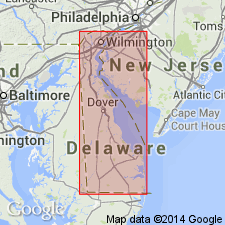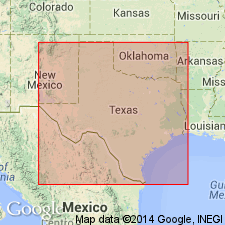
- Usage in publication:
-
- Olds sand
- Modifications:
-
- First used
- Dominant lithology:
-
- Sandstone
- AAPG geologic province:
-
- Permian basin
Summary:
Designated Olds sand (informal, unranked) within the upper part of the Bell Canyon formation of the Delaware Mountain group. Occurs in subsurface of the northern Delaware basin [in Permian basin], in northwest Reeves, Loving, and northeast Culberson Counties, Texas, and in southern Eddy and Lea Counties, New Mexico. Is considered second pay sand [sandstone] in upper Bell Canyon formation. Total thickness in basin not known due to incomplete penetrations. Upper part composed of fine-grained, sand-sized particles of feldspar and quartz that have sedimentary characteristics resembling Ramsey sand (new, informal) of Bell Canyon. Assumed to be discontinuous basin-wide based on similarity to thickness variation of Ramsey sand. Underlies Ford siltstone (new, informal) of Bell Canyon formation and overlies undifferentiated [lower] Bell Canyon formation. Age is Permian (Guadalupian). Report includes generalized structure contour map.
Type gamma ray-sonic log presented but not located. Origin of name not stated by author.
Source: Modified from GNU records (USGS DDS-6; Denver GNULEX).

- Usage in publication:
-
- Olds sandstone member
- Modifications:
-
- Revised
- AAPG geologic province:
-
- Permian basin
Summary:
Redescribed from Olds sand (unranked, informal) to Olds sandstone member (informal). Is part of the upper Bell Canyon Formation of the Delaware Mountain Group, in Delaware basin area [in Permian basin], southwest Texas and southeast New Mexico. Is a producing interval consisting of laminated and clean sandstone facies similar to those of the Ramsey sandstone member (informal) of Bell Canyon. Laminated facies range from 10 to 20+ feet thick. Overlies Hays sandstone member (new, informal) and underlies Ford shale member (informal). Age is Permian (Guadalupian). Report includes stratigraphic chart and subsurface log correlations.
Source: Modified from GNU records (USGS DDS-6; Denver GNULEX).

- Usage in publication:
-
- Olds Member
- Modifications:
-
- Named
- Redescribed
- AAPG geologic province:
-
- Permian basin
Summary:
Pg. 7-10. The Olds Member of the Bell Canyon Formation of the Delaware Mountain Group. The Olds Member, here [formally] named, is in the informal "A" sand in the upper Bell Canyon Formation of the Delaware Mountain Group in the central Delaware basin of Texas and New Mexico. Previously designated the informal unranked Olds sand by Nottingham (1960) and the Olds sandstone member, the main pay in the Olds field, by Grauten (1965). Produces in the Olds, Hays, Quito, and Grice fields. Consists of silty, fine-grained sandstone and has an upward increase in sonic porosity; four separate sand units have been mapped locally. The base is picked at the first shale above the top of the Bell Canyon "B" sand where sonic porosity shows a significant increase. Overlies the Hays Member [new, formal] and underlies the Ford Member [new, formal], both of the Bell Canyon. Is regionally extensive but is absent to the north beneath the Paduca field. Thickness ranges from 0 to 50 feet. [Age is Permian (Guadalupian).]
Type section (subsurface): Gulf J.R. Grandin No. 1 well, sonic-gamma ray log, SE/4 sec. 33, Blk. 29 PSL Survey, Loving Co., TX. Named from the Olds field, Reeves Co., TX.
Source: US geologic names lexicon (USGS Bull. 1565, p. 229).
For more information, please contact Nancy Stamm, Geologic Names Committee Secretary.
Asterisk (*) indicates published by U.S. Geological Survey authors.
"No current usage" (†) implies that a name has been abandoned or has fallen into disuse. Former usage and, if known, replacement name given in parentheses ( ).
Slash (/) indicates name conflicts with nomenclatural guidelines (CSN, 1933; ACSN, 1961, 1970; NACSN, 1983, 2005, 2021). May be explained within brackets ([ ]).

